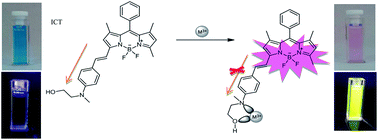Off–on BODIPY-based chemosensors for selective detection of Al3+ and Cr3+versus Fe3+ in aqueous media†
Abstract
Two new off–on BODIPY-based chemosensors that are highly sensitive for trivalent cations in aqueous solutions are described. Compound 2 exhibits selective sensing of Al3+ and Cr3+ versus Fe3+ through two different channels (UV-vis and fluorescence).


 Please wait while we load your content...
Please wait while we load your content...